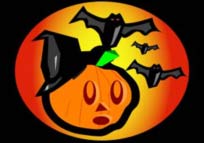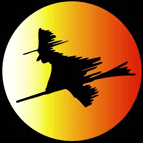|
Our bewildering festival of Halloween or All Hallow's Eve evolved from a mix of ancient Celtic, Roman, and Anglo-Saxn
rituals, incorporating both pagan and Christian traditions. This macabre celebration has evolved into a unique event: a blending
of the frivolous and the frightening, the scular, and the spiritual.The Celts of 447 B.C. ,and possibly even before,'s calendar
reflected their outlook on life. The year was divided into two distinct halves: summer and winter. Summer, from early May
to the end of October, was the period of "the great sun," when light and the life force were at their strongest, and peace
and plenty reigned. Winter, on the other hand, from November to the end of April, was the period of "the small sun" and signified
darkness, death, and impending chaos. But before the existence of calendars, the life of early herding and farming peoples
was dictated by the phases of the moon and the changing seasons of the year. The end of the harvest marked the natural end
of the year for the Celts, when plants died back and any available food was carefull preserved and stored. Samhain was the
turning point between the end of summer and the beginning of the privations of winter. As the weather turned colder and the
days grew shorter, the Celtic community would begin to prepare for the winter that lay ahead. Samhain was also the period
when cattled and sheep were brought down from the hills to their winter enclosures. Those animals that could not be kept through
the winter were slaughtered, and communities once again began to rely on hunting for their meat. Throughout November, bonfires,
or bone-fires, were lit all over Celtic Britain and the flames consumed and purified the butchered remains. November became
known as the Black Month, or Blood Month. Winter claimed many lives among the elderly and the very young. It is little
wonder then, that "Fleadh nan Mairbh," the Feast of the Dead, evolved when slaughter was everywhere and the threat of starvation
loomed over every community. As the land slipped into the gloom of winter, Samhain rituals evolved to protect struggling Celtic
communities. Celts tried to appease their gods and the spirits of their ancestors with gifts, while blazing bonfires were
used to drive back the powers of darkness.For more than a thousand years, the bonfire, or tein, was central to Samhain rituals.
Large bonfires were assembled in the center of every village and on top of every hill. The bonfire was build and a circular,
sun-shaped trench dug around it. On the night of Samhain itself, all the fires in every village were extinguished. The
central fire, or tein eigin, was lit and then each family took home a burning branch or ember to light their New Year's
hearth fire from the blazing communal flame. In Ireland, druid priests maintained a great bonfire, from which every village
rekindled their own Samhain fires. The Tlachtga meath burned in the middle of the country on the sacred hill of
hazel groves( Teamhair, or Tara). Some think that the early Celts believed the souls of the recently deceased could
not pass straight into the "summer lands." Instead they had to wait, lingering in woods and fields until Samhain, when the
onset of winter drove them out of the country side. The Celts believed that the dead not only needed the help of the living
to find their way to the Underworld, but might even want to return to their old homes and families on the way. While
Celts felt they had to appease the spirits of their ancestors, they were also pragmatic and did not want to encourage the
dead to become too comfortable. Typically, Samhain fires served a dual purpose and the Celts saw no incongruity in using fire
to both welcome and drive off wandering souls. Offerings of food and drink were left out, but emty hearths ensured that houses
were cold and unwelcoming to visiting spirits. The central bonfire acted as a beacon, drawing the souls of the dead away from
their previous homes. Hilltop bonfires were also lit, probably to guide spirits on their journey to the "summer
lands," and village boundaries were delineated with flaming torches. These torches acted both to direct the souls onward
and to prevent them from lingering too long.

View My Guestbook
Sign My Guestbook
|



